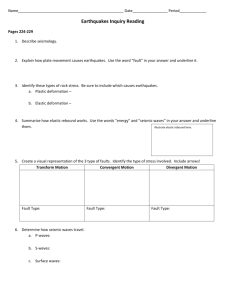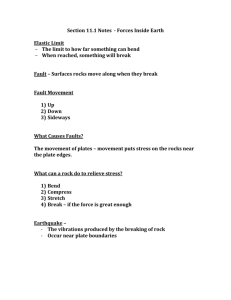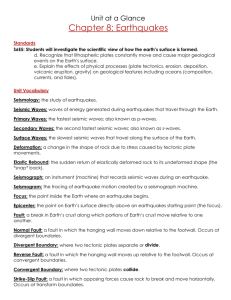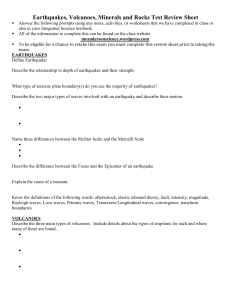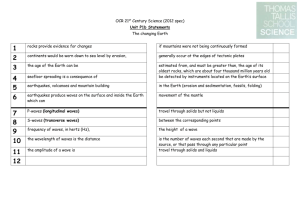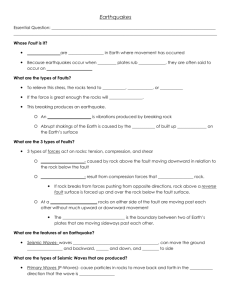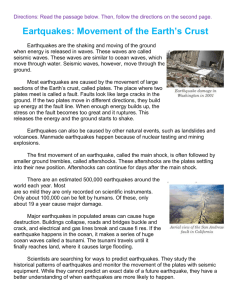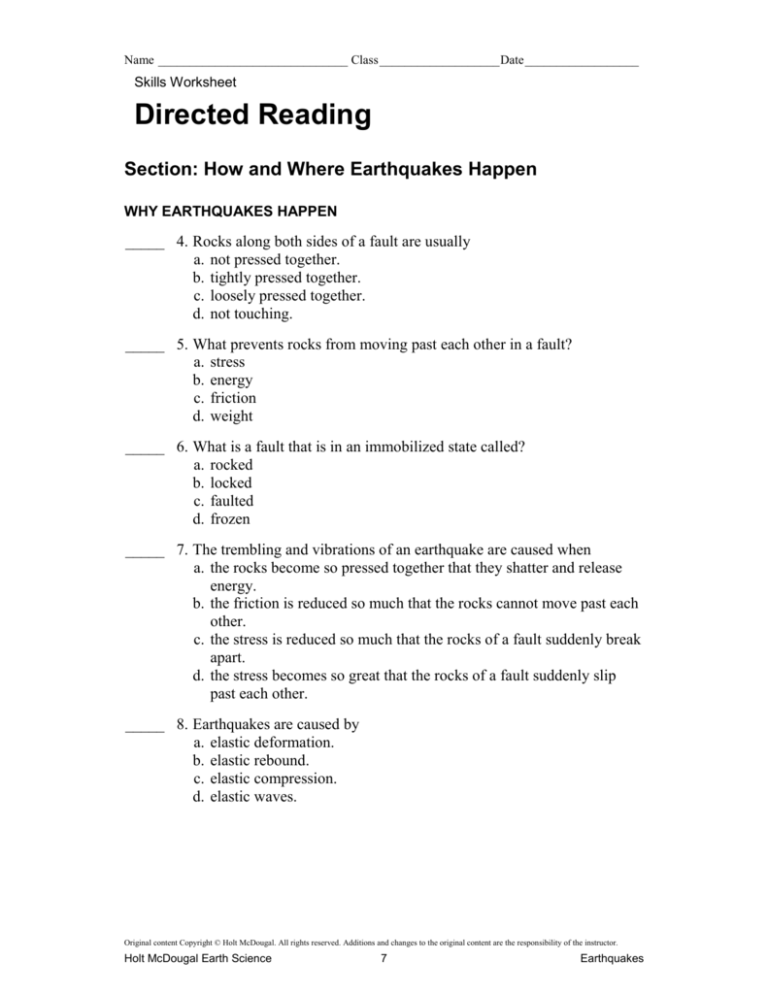
Name ______________________________ Class ___________________ Date __________________
Skills Worksheet
Directed Reading
Section: How and Where Earthquakes Happen
WHY EARTHQUAKES HAPPEN
_____ 4. Rocks along both sides of a fault are usually
a. not pressed together.
b. tightly pressed together.
c. loosely pressed together.
d. not touching.
_____ 5. What prevents rocks from moving past each other in a fault?
a. stress
b. energy
c. friction
d. weight
_____ 6. What is a fault that is in an immobilized state called?
a. rocked
b. locked
c. faulted
d. frozen
_____ 7. The trembling and vibrations of an earthquake are caused when
a. the rocks become so pressed together that they shatter and release
energy.
b. the friction is reduced so much that the rocks cannot move past each
other.
c. the stress is reduced so much that the rocks of a fault suddenly break
apart.
d. the stress becomes so great that the rocks of a fault suddenly slip
past each other.
_____ 8. Earthquakes are caused by
a. elastic deformation.
b. elastic rebound.
c. elastic compression.
d. elastic waves.
Original content Copyright © Holt McDougal. All rights reserved. Additions and changes to the original content are the responsibility of the instructor.
Holt McDougal Earth Science
7
Earthquakes
Name ______________________________ Class ___________________ Date __________________
Directed Reading continued
_____ 9. The sudden return of elastically deformed rock to its undeformed shape
is called
a. elastic rebound.
b. elastic decompression.
c. elastic compression.
d. elastic deformation.
_____ 10. In the process of elastic rebound, rocks on each side of a fault
a. are ground into gravel.
b. move quickly.
c. move slowly.
d. grind to a halt.
_____ 11. What happens if a fault is locked?
a. Stress in the rock decreases.
b. Rocks pull apart.
c. Rocks release energy.
d. Stress in the rock increases.
_____ 12. When rocks are stressed past the point at which they can maintain their
integrity, they
a. fracture.
b. expand.
c. compress.
d. collapse.
_____ 13. After the rocks fracture, what happens?
a. The rocks collapse and fall back to their original shape.
b. The rocks rebound and spring back to their original shape.
c. The rocks are ground into gravel.
d. The rocks release their energy and disintegrate.
_____ 14. The location within Earth along a fault where the first motion of an
earthquake occurs is called the
a. epicenter.
b. fault.
c. focus.
d. shadow.
Original content Copyright © Holt McDougal. All rights reserved. Additions and changes to the original content are the responsibility of the instructor.
Holt McDougal Earth Science
8
Earthquakes
Name ______________________________ Class ___________________ Date __________________
Directed Reading continued
15. Define epicenter.
_______________________________________________________________
_______________________________________________________________
_______________________________________________________________
_______________________________________________________________
20. Where do earthquakes that have deep foci usually occur?
_______________________________________________________________
_______________________________________________________________
21. Why do earthquakes that cause the most damage usually have shallow foci?
_______________________________________________________________
_______________________________________________________________
SEISMIC WAVES
_____ 22. When rocks along a fault slip into new positions, they release energy in
the form of vibrations called
a. tidal waves.
b. elastic waves.
c. seismic waves.
d. focus waves.
_____ 23. Where do seismic waves travel?
a. outward in all directions from the focus through the surrounding
rock
b. inward in all directions from the epicenter through the surrounding
rock
c. outward in all directions from Earth’s core through its surface
d. inward in all directions from the focus through the epicenter
_____ 24. How many main types of waves do earthquakes produce?
a. three
c. two
b. six
d. ten
Original content Copyright © Holt McDougal. All rights reserved. Additions and changes to the original content are the responsibility of the instructor.
Holt McDougal Earth Science
9
Earthquakes
Name ______________________________ Class ___________________ Date __________________
Directed Reading continued
In the space provided, write the letter of the definition that best matches the term
or phrase.
_____ 25. body wave
_____ 26. surface wave
_____ 27. P wave
_____ 28. S wave
a. a seismic wave that travels along the surface of
a medium
b. the fastest seismic wave; causes particles of rock
to move in a back-and-forth direction parallel to
the direction in which the wave is traveling; can
travel through solids, liquids, and gases
c. the second-fastest seismic wave; causes particles
of rock to move in a side-to-side direction
perpendicular to the direction in which the wave
is traveling; can only travel through solids
d. a seismic wave that travels through the body of
a medium
29. What are two other names for P waves?
_______________________________________________________________
_______________________________________________________________
30. What are two other names for S waves?
_______________________________________________________________
_______________________________________________________________
31. How do surface waves form?
_______________________________________________________________
32. What are the two types of surface waves called?
_______________________________________________________________
_______________________________________________________________
33. Rock moves in what way as a result of a Love wave?
_______________________________________________________________
_______________________________________________________________
_______________________________________________________________
34. The ground moves in what way as a result of a Rayleigh wave?
_______________________________________________________________
_______________________________________________________________
_______________________________________________________________
Original content Copyright © Holt McDougal. All rights reserved. Additions and changes to the original content are the responsibility of the instructor.
Holt McDougal Earth Science
10
Earthquakes
Name ______________________________ Class ___________________ Date __________________
Directed Reading continued
SEISMIC WAVES AND EARTH’S INTERIOR
_____ 35. The composition of the material through which P waves and S waves
travel affects
a. the power and duration of the waves.
b. the angle at which the waves travel.
c. the speed and direction of the waves.
d. the intensity and composition of the waves.
_____ 36. Through what type of materials do P waves travel fastest?
a. materials that are not rigid and not easily compressed
b. materials that are very rigid and not easily compressed
c. materials that are not rigid and are easily compressed
d. materials that are very rigid and are easily compressed
39. List Earth’s five mechanical layers.
_______________________________________________________________
_______________________________________________________________
_______________________________________________________________
_______________________________________________________________
_______________________________________________________________
40. Define shadow zone.
_______________________________________________________________
_______________________________________________________________
_______________________________________________________________
42. What happens to seismic waves as they travel through materials of differing
rigidities?
_______________________________________________________________
_______________________________________________________________
_______________________________________________________________
43. Why don’t S waves reach the S-wave shadow zone?
_______________________________________________________________
_______________________________________________________________
_______________________________________________________________
Original content Copyright © Holt McDougal. All rights reserved. Additions and changes to the original content are the responsibility of the instructor.
Holt McDougal Earth Science
11
Earthquakes
Name ______________________________ Class ___________________ Date __________________
44. How does a P-wave shadow zone form?
_______________________________________________________________
_______________________________________________________________
_______________________________________________________________
EARTHQUAKES AND PLATE TECTONICS
In the space provided, write the letter of the description that best matches the term
or phrase.
a. a boundary along which two
continental plates converge,
diverge, or move horizontally in
opposite directions
b. a boundary along which plates
move away from each other
c. an environment in which stress
on rock is the greatest
d. a boundary along which plates
move toward each other and
collide
_____ 45. tectonic plate boundary
_____ 46. convergent plate boundary
_____ 47. divergent plate boundary
_____ 48. continental plate boundary
49. Why do earthquakes occur along mid-ocean ridges?
_______________________________________________________________
_______________________________________________________________
_______________________________________________________________
FAULT ZONES
_____ 50. A fault zone is a region of
a. numerous closely spaced faults.
b. a few closely spaced faults.
c. Earth’s core where the rocks form faults.
d. Earth’s mantle where faults form.
Original content Copyright © Holt McDougal. All rights reserved. Additions and changes to the original content are the responsibility of the instructor.
Holt McDougal Earth Science
12
Earthquakes
Name ______________________________ Class ___________________ Date __________________
Directed Reading continued
51. Why do fault zones occur at plate boundaries?
_______________________________________________________________
_______________________________________________________________
_______________________________________________________________
_______________________________________________________________
53. How did the New Madrid, Missouri, earthquakes in 1811 and 1812 differ from
many other major earthquakes in the United States, in terms of their location?
_______________________________________________________________
_______________________________________________________________
_______________________________________________________________
54. What was discovered in the Mississippi River region in the late 1970s?
_______________________________________________________________
_______________________________________________________________
Original content Copyright © Holt McDougal. All rights reserved. Additions and changes to the original content are the responsibility of the instructor.
Holt McDougal Earth Science
13
Earthquakes

